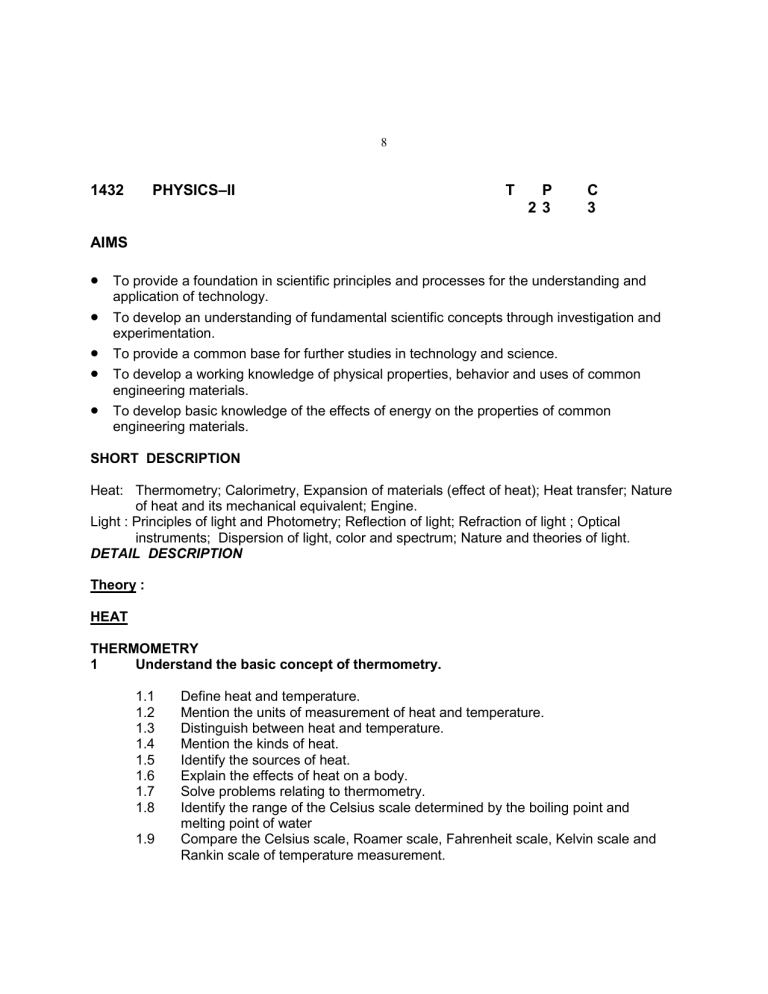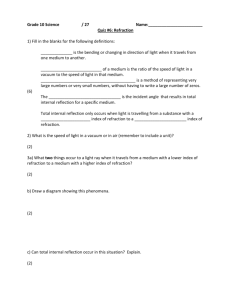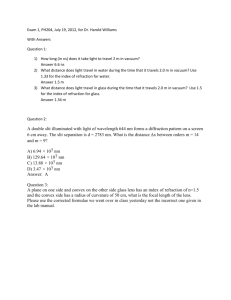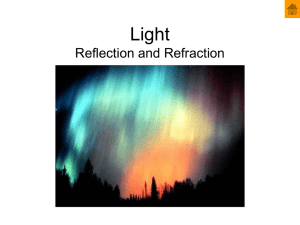PHYSICS-II

1432 PHYSICS –II
AIMS
8
T P
2 3
C
3
To provide a foundation in scientific principles and processes for the understanding and application of technology.
To develop an understanding of fundamental scientific concepts through investigation and experimentation.
To provide a common base for further studies in technology and science.
To develop a working knowledge of physical properties, behavior and uses of common engineering materials.
To develop basic knowledge of the effects of energy on the properties of common engineering materials.
SHORT DESCRIPTION
Heat: Thermometry; Calorimetry, Expansion of materials (effect of heat); Heat transfer; Nature of heat and its mechanical equivalent; Engine.
Light : Principles of light and Photometry; Reflection of light; Refraction of light ; Optical instruments; Dispersion of light, color and spectrum; Nature and theories of light.
DETAIL DESCRIPTION
Theory :
HEAT
THERMOMETRY
1 Understand the basic concept of thermometry.
1.1 Define heat and temperature.
1.2 Mention the units of measurement of heat and temperature.
1.3 Distinguish between heat and temperature.
1.4 Mention the kinds of heat.
1.5 Identify the sources of heat.
1.6 Explain the effects of heat on a body.
1.7 Solve problems relating to thermometry.
1.8 Identify the range of the Celsius scale determined by the boiling point and melting point of water
1.9 Compare the Celsius scale, Roamer scale, Fahrenheit scale, Kelvin scale and
Rankin scale of temperature measurement.
9
2 Understand the features of thermometers.
2.1 State the construction and graduation of a mercury thermometer.
2.2 Describe the operation of different types of thermometers (e.g., maximum and minimum thermometer, clinical thermometer).
2.3 Mention the application of different types of thermometers (e.g., maximum and minimum thermometer, clinical thermometer).
HEAT CAPACITY OF MATERIALS (CALORIMETRIC)
3 Understand the concept of specific heat.
3.1 State the heat as a form of energy.
3.2 Define specific heat capacity.
3.3 State SI units of measurement of specific heat capacity as J/Kgc 0 or J/Kgk 0 .
3.4 Define thermal capacity and water equivalent.
3.5 Differentiate between thermal capacity and water equivalent.
3.6 Mention the specific heat capacity of different materials.
3.7 Prove the total heat gained by an object is equal to the sum of the heat lost by all the surrounding objects.
3.8 Identify the total heat gained and the total heat lost in a given system.
3.9 Solve the problems relating to specific heat.
4 Understand the concept of latent heat.
4.1 Identify specific latent heat as the energy consumed or liberated when water vaporizes or condenses and when ice melts or freezes.
4.2 Explain the effects of a change in pressure on the melting point and boiling point of water.
4.3 Define various kinds of specific latent heat.
4.4 Determine the latent heat of fusion and vaporization from given data.
4.5 Solve problems relating to latent heat.
EFFECTS OF HEAT ON DIMENSION OF MATERIALS
5 Understand the effects of heat on solids.
5.1 Show that different materials change in size at different amounts with the same heat source.
5.2 Explain the meaning of differential expansion in bimetallic strip, thermostats, compensated pendulum etc.
5.3 Describe the capacity of bimetallic strip, thermostats and compensated pendulum.
5.4 Explain the methods of overcoming problems caused by the expansion of materials in buildings, machinery, railway lines and bridges.
5.5 Define the co-efficient of linear, superficial and cubical expansion of solids.
5.6 Mention the units co-efficient of linear, superficial and cubical expansion of solids.
5.7 Mention the linear, superficial and cubical expansion of a range of common engineering materials.
10
5.8 Solve problems related to effect of heat on solids.
6 Understand the effect of heat on liquids.
6.1 Define real and apparent expansion of liquid .
6.2 Define the co-efficient of real and apparent expansion of liquid.
6.3 Explain the effect of real and apparent expansion of liquid.
6.4 Distinguish between the co-efficient of real and apparent expansion of liquid.
6.5 Determine the co-efficient of real and apparent expansion of liquid.
6.6 Solve problems relating to effects of heat on liquids.
HEAT TRANSFER
7 Understand the of fundamental principles of heat transfer.
7.1 Identify the phenomenon of heat transferring from hot bodies to cold bodies.
7.2 Explain the methods of heat transfer by conduction, convection and radiation with examples of each type of transfer.
7.3 Define thermal conductivity (K) & rate of heat transfer.
State the SI units of thermal conductivity as
Ошибка!
or Ошибка!
7.4 List the factors which determine the quantity of heat (Q) flowing through a material.
7.5 Show that the quantity of heat flowing through a material can be found from Q =
Ошибка!
7.6 Outline the properties of materials which give thermal insulation.
7.7 List practical examples of the application of thermal insulation properties (e.g., refrigerators, vacuum flasks and building insulation).
7.8 Solve problems related to heat transfer.
NATURE OF HEAT AND ITS MECHANICAL EQUIVALENT
8 Understand the aspects of mechanical equivalent of heat.
8.1 Describe the caloric theory and kinetic theory of heat.
8.2 State the drawbacks of the caloric theory of heat.
8.3 Explain the mechanical equivalent oh heat.
8.4 Mention the mechanical equivalent of heat.
8.5 Explain the first law of thermodynamics.
8.6 Solve problems relating to the mechanical equivalent of heat.
HEAT ENGINE
9 Understand the concept of heat engine.
9.1 State what is meant heat engine.
9.2 Explain the principle of work of a heat engine.
9.3 Identify thermal efficiency of a heat engine.
9.4 Explain the working principles of internal combustion and external combustion engines (with fair sketches).
9.5 Distinguish between internal combustion engine and external combustion engine.
11
LIGHT
9.6 Distinguish between steam engine and petrol engine.
PRELIMINARIES OF LIGHT AND PHOTOMETRY
10 Understand the concept of preliminary light & photometry.
10.1 Define light, medium (transparent, translucent, opaque), luminous & nonluminous bodies, parallel, convergent & divergent rays, beam.
10.2 Show the travel of light in straight line.
10.3 Define photometry, luminous intensity, luminous flux, brightness and illuminating power.
10.4 Mention the units of luminous intensity, luminous flux, brightness and illuminating power.
10.5 Mention relation between luminous intensity & illuminating power.
10.6 Explain inverse square law of light.
10.7 Describe the practical uses of light waves in engineering.
10.8 Solve problems relating to photometry.
REFLECTION OF LIGHT
11 Understand the features of reflection of light at plane and spherical surfaces.
11.1 Define mirror (plane & spherical ), image (real & virtual) and magnification of images.
11.2 Describe the reflection of light.
11.3 State the laws of reflection of light.
11.4 Express the verification of laws of refraction.
11.5 Define pole, principle axis, center of curvature, radius of curvature, principal focus in case of concave & convex mirrors.
11.6 Find the relation between focal length & radius of curvature of a concave & convex mirror.
11.7 Express the general equation of concave and convex mirror.
11.8 Determine the position , nature and size of the images of an object formed by a spherical mirror when the object is moved from infinity towards the pole of the mirror.
11.9 Solve problems relating to reflection of light at plane and spherical surfaces.
REFRACTION OF LIGHT
12 Understand the concept of refraction of light at plane surfaces.
12.1 Define refraction of light.
12.2 Give examples of refraction of light.
12.3 State the laws of refraction.
12.4 Express the verification of laws of refraction.
12.5 Define absolute and relative refractive index.
12.6 Relate absolute and relative refractive index.
12.7 Explain the meaning of total internal reflection and critical angle.
12.8 Relate total internal reflection and critical angle.
12.9 Give examples of total internal reflection.
12.10 Describe refraction of light through a prism.
12
12.11 Express the deduction of the relation between refractive index, minimum deviation and angle of the prism.
12.12 Solve problems related refraction of light at plane surface.
13 Understand the concept of refraction of spherical surface.
13.1 Define lens.
13.2 Identify the types of lens.
13.3 Define center of curvature, radius of curvature, principal axis, 1st and 2nd principal focus, optical center and power of lens.
13.4 Express the deduction of the general equation of lens (concave & convex).
13.5 List uses of lens.
13.6 Find the position, nature & sizes of Image at different position of an object formed by a lens (convex & concave) when the object is moved from infinity towards the optical center of the lens.
13.7 Solve the problems relating to refraction of spherical surface.
OPTICAL INSTRUMENTS
14 Understand the features of telescope & microscope.
14.1 Explain the construction of light ray patterns for simple & compound microscope
(with diagram).
14.2 Explain the construction of light ray patterns for Astronomical & Gallillian telescope (with diagram)
14.3 Describe the common defects of eye.
14.4 Describe the remedy of common defects of eye.
14.5 Distinguish between eye and camera.
DISPERSION OF LIGHT, COLOR AND SPECTRUM
15 Understand the concept of dispersion of light, color and spectrum.
15.1 Describe dispersion of light & spectrum.
15.2 Define pure & impure spectrum.
15.3 Describe the production of pure spectrum.
15.4 Identify different types of spectra.
15.5 Explain emission spectra, absorption spectra and color of bodies.
15.6 Identify the results of adding primary and secondary color.
15.7 Explain absorption, reflection and filtration of color light.
Practical:
Heat
1. Compare the operation of common thermometers.
2. Determine the coefficient of linear expansion of solid by Pullinger’s apparatus.
3. Measure the specific heat capacity of various substances.
4. Investigate the latent heat of fusion and vaporization of water.
5. Investigate the effect of heat on the dimensions of solids and liquids.
6. Measure the different rates of expansion of common metals.
13
7. Determine the water equivalent by calorimeter.
LIGHT
8. Compare the luminous intensity of different light sources.
9. Establish the characteristics of various shaped mirrors by investigating the behavior of light rays reflected from the mirrors.
10. Verify the laws of reflection.
11. Find out the focal length of a concave mirror.
12. Study the behavior of light patterns passing through various lenses for characteristics of the lenses and nature & position of the produced imaged.
13. Determine the refractive index of a material medium.
14. Find out the focal length of a convex lens.








